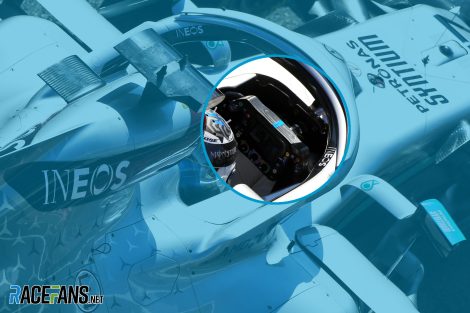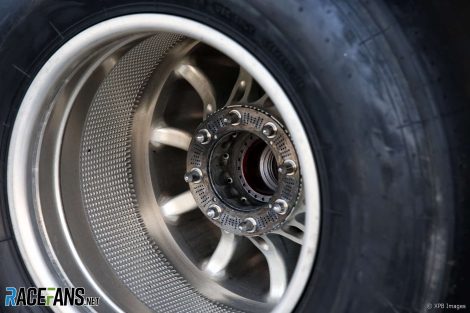When Mercedes’ Dual Axis Steering system appeared during pre-season testing, one immediate questions was: ‘Who will copy it first?’
From the device’s first appearance on day two of testing – February 20th – to the intended start date of the 2020 F1 season less than a month later, it would have been impossible for the Silver Arrows’ rivals to produce their own versions.Ferrari team principal Mattia Binotto ruled out the possibility of adding a DAS-style system to the SF-1000 in time for the original start date of the championship. “It’s an entire concept design, producing homologation, just to be safe,” he said at the time. “So if it is, I think it can be like mid-season, not earlier.”
Then the unthinkable happened. In an unprecedented turn of events, the season was put on hold as a pandemic swept the globe. No cars have run since testing finished on February 28th, and the earliest we can currently expect to see F1 resume racing is June 14th.
Has that handed Mercedes’ rivals the chance to copy DAS in the meantime? Having revealed their hand in testing, has fate conspired to rob the world champions of the advantage they might have taken from it?
Any teams who were looking at creating their own version of DAS now have an added incentive to do so. The postponement of F1’s 2021 technical regulations means the current chassis will remain in use until next year. DAS would have been outlawed under the 2021 rules, but anyone who gets it onto their car this year can now run it for an extra season.
However, the decision to bring forward the summer factory shutdown to now means Mercedes’ rivals cannot get to work on their own DAS devices at the moment. Development suspended until the teams return to their factories prior to the start of the season, whenever that may be. Lockdowns in several countries, forcing staff to work from home, add a further complication.
Advert | Become a RaceFans supporter and
As things stand, Canada will host the opening round of the championship in mid-June. But a further delay to the season and potential extension of the factory shutdown will lessen the likelihood Mercedes’ rivals will be able to copy DAS.

“It’s a significant project,” he said, “significant to the point where I suspect it would require a new chassis from where we are now.”
Speaking prior to the decision to postpone the 2021 regulations, Green added “even if the rules weren’t changing next year, I doubt whether we would be introducing something like that for this year.”
Furthermore, the question remains how badly Mercedes’ rivals need DAS. The system, which allows the driver to adjust the toe angle of the front wheels, appears to have been designed to aid tyre management. This has been a persistent thorn in the teams’ side, despite their dominant sweep of the last six world championships.
The year before that title run began, Mercedes’ 2013 car was plainly fast over a single lap (it took eight pole positions), yet often struggled with tyre degradation on race day. It was during this time the team courted controversy by conducting a controversial, secretive tyre test with Pirelli during the week after the Spanish Grand Prix.
Go ad-free for just £1 per month
>> Find out more and sign up
Even during the peak of their dominance, tyre performance occasionally wrong-footed Mercedes. This weakness was exposed again at the Singapore Grand Prix in 2015. The unusual combination of a low-grip circuit with tight, technical corners and high temperatures saw Mercedes struggle with tyres all weekend. In a season where they started every other race from pole position, on this occasion they were closer to the midfield than the front-runners.

In Mexico the team suffered badly with its rubber. “I don’t think that we had one single lap where we actually switched the tyre on,” lamented team principal Toto Wolff after the race. However on that occasion it was front tyre performance, not rear, which hobbled Mercedes.
Based on comments from their drivers, DAS clearly had a long gestation, which must have begun in the months following that race in Mexico. This indicates two things: First, that anyone wanting to copy it will need time to do so – and the current hiatus may help with that; and second, the reason Mercedes developed DAS before any of its rivals in the first place suggests it came about to fulfil a particular need and address a specific weakness on their car. Necessity, after all, is the mother of invention.
Whether other teams value the opportunities offered by DAS as highly will be revealed if they use the current hiatus to device their own versions of the system. Whatever the circumstances, due to the complex nature of the system, they will not gamble on it if they do not believe it will improve the performance of their own cars.
Advert | Become a RaceFans supporter and
2020 F1 season
- Pictures: Wrecked chassis from Grosjean’s Bahrain fireball crash to go on display
- Bottas vs Rosberg: Hamilton’s Mercedes team mates compared after 78 races each
- F1 revenues fell by $877 million in Covid-struck 2020 season
- Hamilton and Mercedes finally announce new deal for 2021 season
- F1 audience figures “strong” in 2020 despite dip in television viewers





Chris (@altitude2k)
31st March 2020, 12:43
Even if they do introduce it, the other teams’ lack of testing a DAS implementation means Mercedes still have a significant advantage when it comes to hitting the first race weekend.
Chaitanya
31st March 2020, 13:01
Given the legality of this system is brought into question, rivals will take a little longer than usual to implement the said system
anon
31st March 2020, 17:58
The thing is, in questioning the legality of this system, some teams might in turn open themselves up to similar questions as well on their steering systems.
Giorgio Piola has written an article in the Italian press that indicates Ferrari have been running similar experiments on their steering systems on the SF1000, although in their case it seems to be more about varying the ackermann geometry of the steering system as the driver steers through a corner.
Phylyp (@phylyp)
31st March 2020, 13:17
Good summary, thanks Josh. Also, stay safe, friend, it looks like the US is determined to be #1 in this pandemic as well.
BasCB (@bascb)
31st March 2020, 14:22
With the latest news being that teams (including Mercedes) have agreed to ban DAS for the 2021 season today, I guess the only advantage Mercedes will have from it is the few races we’ll have this season. On the other hand, it seems highly unlikely now that anyone would make the effort to get it on their cars as well.
Robbie (@robbie)
31st March 2020, 14:40
@bascb Agreed. Had the same thoughts.
Jamie B
31st March 2020, 14:52
They announced a while ago that DAS will still be banned in 2021
NS Biker (@rekibsn)
31st March 2020, 19:56
For all the talk about DAS, it seems to boil down to an on-track front wheel toe adjustment system. There has been much discussion of what it does, why would you want that to happen and what side benefits are there, but no clear explanation of what and why.
Ride height, some suggestion that changing the steering angle will change the ride height. Yes this is legit, but the small angles from DAS are not likely to do much. It could be positive, but the steering angles being generated are very small.
Toe in or out on the straights, yes it does this but what is it you want it to do? To reduce scrub and drag, to heat up the tyres by increasing scrub or to get a gain in straight line stability?
Toe in or out and Ackerman angles when cornering. It will permit you to run different (more or less) toe on the straights than when cornering, if the emphasis is on gains during cornering and “normal” geometry on the straights then it is a cornering focus.
Bump steer compensation at high speed and high down-force conditions. With the very small suspension travel and the smart folks designing suspension systems, not likely that there is much bump steer inherent in these cars, but, with DAS you could possibly use it and now we’re back to geometry compensation on the straights.
It would be great to be a fly on the wall at Mercedes and get the low-down on what the real benefit of the system is. We are just going to have to wait till the story comes out.
Now that the Genie is out of the bottle, at least till 2021, bet we see a couple of teams developing the system and now is a really good time to be doing it.
Balue (@balue)
31st March 2020, 21:34
I still believe this will be deemed a moveable aerodynamic device if it’s challenged in court.
anon
1st April 2020, 0:02
@balue why exactly do you think it is going to be declared a “moveable aerodynamic device”? For a start, some teams might not be quite so keen to protest as you suggest, as at least one – Ferrari – seems to be exploiting a similar loophole if Piola is right, so protesting Mercedes might not be in their favour.
Firstly, the general consensus is that the aerodynamic benefits from DAS are likely to be effectively negligible, and the more logical explanation is, as others have noted, this seems to be a lot more about front tyre wear management.
Secondly, you would also need to come up with a ruling that does not, at the same time, technically make the act of steering a car in itself a form of “moveable aerodynamic device” – as the act of steering itself, by altering the attitude of the car, might in itself also thus count as a “moveable aerodynamic device”.
On what do you therefore base your claim this is a “moveable aerodynamic device”?
Balue (@balue)
4th April 2020, 19:01
Negligible or not, if it’s a moveable device that helps aero, that’s that, and just because something’s controlled via the steering wheel doesn’t mean it’s steering.
Simon White
1st April 2020, 6:11
If the races continue through next winter, the cooler temperatures could also help Mercedes.